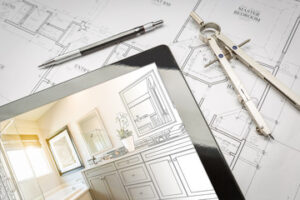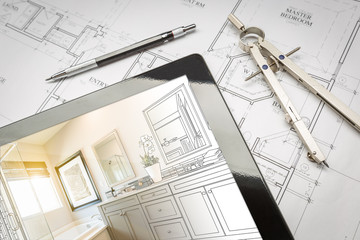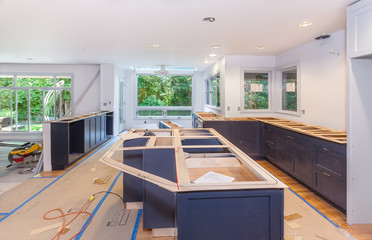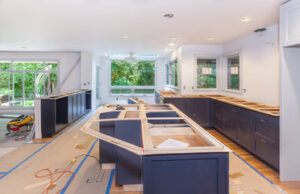A bathroom is an important room to get right. Whether you’re building a new bathroom or renovating your existing one, careful planning can save you money and hassle down the road.
Before you start dreaming of his-and-her sinks and a statement walk-in shower, you’ll need to work out how your bathroom will function and what’s possible within your space. Talk to Milwaukee Bathroom Remodeling experts or read on.

Measure the Space
Getting your bathroom measurements right is one of the most important things you can do. This will help you avoid costly mistakes and get the most out of your space. A tape measure, a pen, and some paper are the best tools to have, but an app or program can ease the process and make for more accurate numbers. Having a second pair of hands also helps as it will allow you to move around the room and measure different areas more quickly.
Start by measuring the length and width of the room, ensuring you include alcoves and other spaces that could be used for storage or as part of your bathroom design. You can then use these measurements to work out the maximum size of the bath, basin, and shower enclosure that you can fit into the space. You should also note down the position of any existing plumbing and water pipes so you don’t have to spend extra money moving them when reworking your bathroom layout.
Now you’re ready to start planning your new bathroom layout. Think about how you plan to use your bathroom and choose the fixtures that will make it work best for you. Depending on your needs, this could mean choosing a tub over a walk-in shower or even just changing where you put everything like the loo and sink to give the room a more functional feel.
It’s worth considering whether you want your bathroom to be symmetrical or not at this point, as well as what fixtures and fittings are already in place and cannot be moved. It’s also a good idea to ask friends and family who have recently undertaken bathroom renovations what they would recommend in your situation.
Before you start making any changes, it’s important to make a detailed plan of the whole room, including any windows or doors that are present. This will give you an idea of how your finished bathroom will look once the redesign is complete. It will also help you to decide if there are any areas where you can add storage or other finishing touches, such as a towel rail or shelving unit.
Think About Ventilation
When a bathroom isn’t ventilated, excess moisture can cause mildew and mold to build up over time, destroy paint and wallpaper, warp wallboard, and damage cabinets, and rust fixtures. It also causes the room to cool down quickly, consuming energy to heat it back up. Ventilation is a must for all bathrooms, even the smallest.
Fortunately, modern ventilation systems are quieter and more efficient than ever. Look for a model that offers at least 100 CFM (cubic feet per minute), and preferably more. You’ll want to be sure it has a thermostat that will automatically turn on and off with your bathroom fan. Also, choose a model with a built-in humidity sensor to avoid over-venting. Finally, make sure the exterior vent louver closes completely when the fan isn’t running to prevent cold air from seeping into your home.
You may also want to consider a vent fan with beautiful cladding or a recessed or semi-recessed design that blends in with your bathroom’s style. Also, be sure the vent is insulated around the flexible duct that runs from the bathroom to the outside, and insulate the exterior cap as well.
Another important element to think about is the amount of use your bathroom will receive. A bathroom that’s used by a family daily will need a different layout than one that’s used just once or twice a month.
Getting the whole family involved is also a good idea here, as people tend to have very different ideas about what they like and dislike. For example, a freestanding bath might be ideal for someone who enjoys a soak, but your partner might prefer the practicality of a walk-in shower. Once you have a good understanding of what your needs and wants are, it’s time to get started on the fun stuff. Decorative items like paint, wallpaper, and tile can be changed fairly easily, but sanitaryware, appliances, and smart tech will be permanent fixtures. This is why it’s so important to think through your entire plan carefully before you start buying anything.
Consider Storage
Bathrooms have evolved from simple places to wash up and use the toilet into full-blown health and beauty centers, a place where style is just as important as functionality. But getting that balance right is a bit of a tricky thing, especially when it comes to storage. If you don’t plan for enough storage, even the best-equipped bathroom can quickly feel disorganized and cluttered.
Luckily, there are lots of ways to add extra storage without changing your layout. One easy option is to take advantage of vertical space with a ladder-style shelf unit which provides plenty of storage while adding a pretty pop of color to the room. Open shelving can also be a great way to store a lot of items that would clutter a cabinet, such as toiletries, towels, and even makeup.
If you’re not sure what to do with a space, hotel bathrooms are always a fabulous source of inspiration and often offer the perfect combination of style and functionality. Another easy option is to rework existing storage elements like closets, cabinets, and drawers by rehanging doors and repainting them to create a new look without having to move plumbing or electrical lines.
Remember that it’s important to think through what you want to store and where before you start the remodel because moving a fixture or storage piece mid-remodel can throw off your entire schedule and cost a fortune in plumbing and electrical costs. That’s especially true in tight-fitting bathrooms where each change can potentially displace other fixtures and lead to costly water leaks or electrical issues.
Another great idea is to build storage into your renovation project by choosing vanities with plenty of room underneath for linens or cabinets that can incorporate built-in storage for items like shampoo bottles, toiletries, and cleaning supplies. You can also utilize a wall-mount sink for a more streamlined look in smaller bathrooms, or enlist a freestanding storage cart to hold everything from body salts to sponges. Then simply roll the cart out when it’s time to get your beauty on, and put it back when you’re finished.
Think About Lighting
Adding lighting layers can help transform a bathroom from clinical to cozy. Ambient lighting – gentle light that fills the room and bounces off the ceiling – is important, but consider other types of lighting as well. Pretty wall sconces, like those in this powder room by Ashley Whittaker Design, add eye candy while providing soft pools of light perfect for reading or doing makeup. For a more dramatic effect, use decorative fixtures with a more architectural style and materials, such as marble or wood, for a customized look.
When it comes to showers, tubs, and sinks, it’s all about getting the light right. Typically, we recommend using fixtures with white, diffused shades because they distribute light evenly and offer the best overall lighting. If your space requires recessed lights, consider upgrading to flood-style fixtures, which provide more direct, glare-free illumination.
The right lighting can make a small bath feel bigger and a large bathroom feels more intimate, so it’s worth taking the time to carefully consider your options. Luckily, there are plenty of online tools available to help you map out your bathroom and experiment with different lighting options.
One such tool is a free, user-friendly 3D software program that allows you to draw up a floor plan and experiment with different designs. It’s easy to drag and drop tiles, mirrors, and appliances to see how they fit together — it’s even possible to add natural light with windows or doors to get a more accurate sense of how the finished space will look.
Remember, it’s always best to seek professional advice before starting a new project, especially when working with complicated spaces such as bathrooms. An experienced designer can help you find a way to work within the rules of thumb and create a comfortable, functional bathroom that works for your family’s needs. A good designer can also save you money in the long run by helping you avoid costly mistakes.




